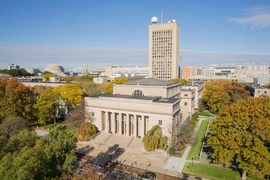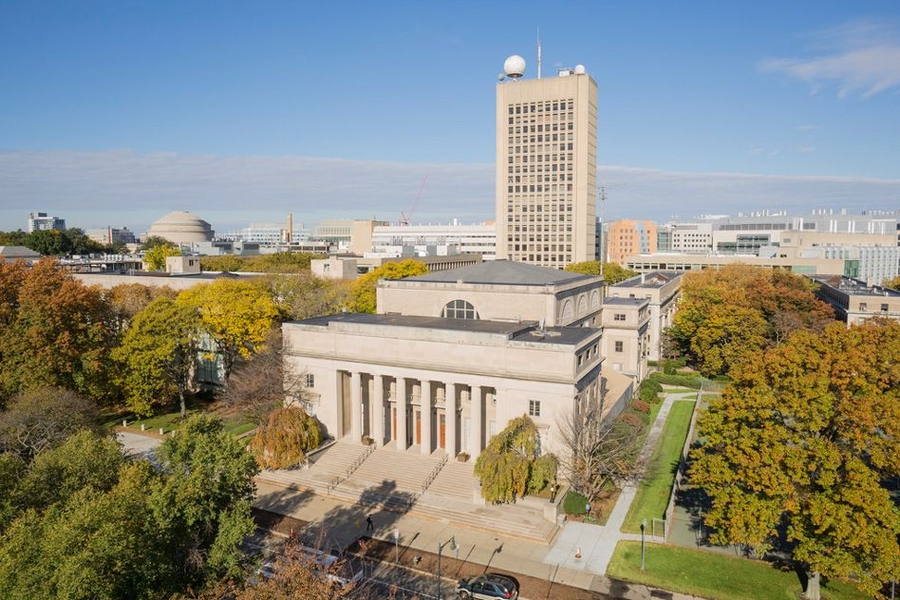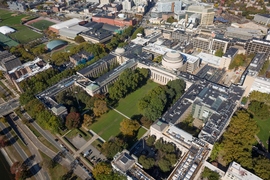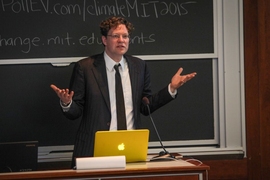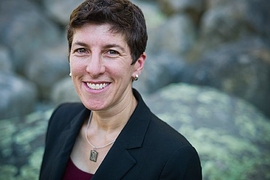A group of recommendations issued today sets MIT on a path to align its campus operations along a core set of sustainability principles, setting a strong foundation for rigorous and innovative Institute-wide goal setting, measurement and verification, and implementation of strategies moving forward.
These recommendations — titled “The Sustainability Working Group Recommendations: An integrative vision for our buildings, stormwater, landscape and labs” — follow a 10-month process guided by the MIT Office of Sustainability. These recommendations are aligned with and advance the recently released MIT Plan for Action on Climate Change, which calls for a series of actions that lead to a local response to climate mitigation, adaptation, and resiliency.
This initial report also sets in place a process to develop a comprehensive set of goals for reducing the use of energy and water on campus, which will be established by June 2016. With the release of these recommendations and a timetable for establishing concrete goals, says director of sustainability Julie Newman, “we now have a mechanism by which to transform MIT into a state-of-the-art sustainable campus over time.”
The process will be overseen by the Campus Sustainability Task Force, launched last March and charged with developing a vision and blueprint for a sustainable MIT. The task force also needs to consider how to develop criteria for assessing how well the Institute is doing in meeting those goals. The body meets twice a month, Newman says, to address questions as, “How can MIT be a game-changing force for campus sustainability for the 21st century?” The task force is co-chaired by Newman and Andrea Campbell, head of MIT’s Department of Political Science and the Arthur and Ruth Sloan Professor of Political Science.
The new set of recommendations was produced by Sustainability Working Groups focused on four broad areas, which have been meeting over a 10-month period to hammer out this initial set of plans.
The first area is the design, construction, and renovation of buildings on the MIT campus. MIT is now committed to meeting or exceeding the newest version of the national LEED Gold (version 4) certification standard for new campus construction and major renovation. Recent examples of buildings that have achieved the LEED Gold (version 3) standard were Building E62 (MIT Sloan School of Management) and Building 76 (Koch Institute for Integrative Cancer Research). But the recommendations say that “MIT’s ambitious capital renewal plan and an institutional commitment to sustainability necessitate an even more strategic, innovative, and consistent approach to integrating sustainable, high-performance practices across all building types.”
Implementing that, the recommendations say, should include prioritizing energy-efficiency strategies and carbon emissions reduction in both new and existing campus buildings, enabling MIT to achieve the goal of reducing emissions by at least 32 percent by 2030. Design strategies using full lifecycle analysis that place a market price on carbon to evaluate design and energy-efficiency measures are being implemented. The plan also calls for continuous optimization and enhancements through buildings’ lifetimes.
The second area is the management of storm water and campus landscaping. Recommendations include working to enhance the water quality of the Charles River, which is adjacent to the 168-acre campus; fostering the resiliency of both the land and water systems in the face of changing climate; and developing ways to have the built environment of the campus better mimic the natural hydrological cycle that helps to maintain healthy soil and water.
Management of materials and waste is the third area of the recommendations. These include supporting a lifecycle approach to the procurement of products and materials in order to maximize human and ecological health; minimizing waste and unnecessary consumption; and improving the recycling and reuse of materials to make sure that, whenever possible, all materials can be disassembled and repurposed after their initial uses.
Fourth, the recommendations address improvements to the many kinds of laboratory spaces on campus. The goals include optimizing the use of water, reducing waste, encouraging the use of less-hazardous materials, and adopting sustainable practices. While it is important to make laboratory spaces and practices as sustainable as possible, it’s essential to make sure that this does not in any way detract from the cutting-edge work of those labs, the report emphasizes.
Altogether, this new set of recommendations and processes “will put the MIT campus on a trajectory toward sustainability,” Campbell says. The idea, she says, is not just to follow known best practices, but given MIT’s stature as a nexus of innovation, “for MIT to become an exemplar for developing new and self-reinforcing processes” that can be followed by others, she says.
“We are taking concrete steps to approaching campus operations in new ways so that MIT can evolve as a model for a sustainable campus,” says Executive Vice President and Treasurer Israel Ruiz. “The Sustainability Working Group recommendations respond to MIT’s Plan for Action on Climate Change, which calls on our community to use the campus as a test bed for change.”
The working groups have also developed “a set of working principles and criteria for evaluating success,” Newman says, so that there are clear ways of measuring progress toward meeting the broad goals they have outlined. “We need a new set of metrics,” she says.
“Like the dual nature of [MIT’s motto] ‘mind and hand,’ an ecologically healthy campus landscape can enrich our MIT community through both beauty and service,” says Laura Tenny, a senior campus planner at MIT who served on two of the four working groups that prepared the recommendations. Such a landscape “can be planned, designed, and managed as a working system that provides ‘ecosystem services,’ where healthy soils act like a sponge to collect and filter rainwater before it reaches the Charles River; diverse plant communities provide habitat for birds and pollinators; and safe, attractive, accessible campus green spaces encourage people to get outdoors year-round to experience moments of nature in the city,” she says.
This is just the beginning of a long process, Newman and Campbell emphasize. This new report provides the recommendations of the first four working groups, Campbell explains, but there will be additional reports coming from other working groups, dealing with issues ranging from sustainability data analytics, to climate mitigation and vulnerability, to student sustainability leadership.
The Campus Sustainability Task Force, in collaboration with the Office of Sustainability, will also be launching an “idea bank” in December to solicit input from all members of the MIT community. The hope is that many new initiatives will emerge from students and faculty, in some cases in the form of class projects. “Part of our hope is to harness the talent here from this population,” Campbell says.
It makes sense for MIT to be at the forefront of developing sustainable practices, Campbell says, both because of this community’s expertise and the long time horizons that an academic institution can provide for planning. “A university campus is an ideal environment in which to implement sustainability,” she says. “It’s really about creating a durable system where we’re always incorporating the best new ideas, because we know this whole field is going to be continually evolving.”
